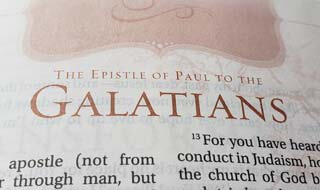 When I was a member of a Christian musical group, we visited York, England. What I remember most about that city is the cathedral. I was awed by the grandeur, size, and architecture of that centuries-old church.
When I was a member of a Christian musical group, we visited York, England. What I remember most about that city is the cathedral. I was awed by the grandeur, size, and architecture of that centuries-old church.
What impressed the writer of Psalm 84 was the significance of the Old Testament temple. He testified of his zeal for worship:
“My soul longs, yes, even faints for the courts of the LORD;
my heart and my flesh cry out for the living God.
Even the sparrow has found a home,
and the swallow a nest for herself,
where she may lay her young–even Your altars,
O LORD of hosts, my King and my God” (vv.2,3).
The psalmist used the imagery of a bird nested in a lofty corner of the temple to express his desire for unhindered access to the designated place of worship–truly a bird’s eye view! Do we value corporate worship with this kind of enthusiasm?
Many do not; they question if church attendance is even necessary for the Christian. Philip Yancey addresses such issues in his book: Church: Why Bother? He states:
“Winston Churchill once said that he related to the church rather like a flying buttress: he supported it from the outside. I tried that strategy for a while, after I had come to believe the doctrine sincerely and had committed myself to God. I am not alone. Far fewer people attend church on Sunday than claim to follow Christ. Some of them … feel burned or even betrayed by a former church experience. Others simply ‘get nothing out of church.’ Following Jesus is one thing; following other Christians into a sanctuary on Sunday morning is quite another. Why bother?” [1]
Good question–do we need to “bother” with church involvement these days?
To find the right answer, we need to view the church, not from across the street, nor just from the pews, but from above. God’s Word reveals much about His “called-out assembly.”
The term used for “church” in the New Testament is the Greek ekklesia. It combines two words: “ek,” meaning “out of,” and “kaleo,” meaning “to call.” The church is therefore the assembly of God’s “called-out ones.” At the council of Jerusalem, James testified that, “God … visited the Gentiles to take out of them a people for His name” (Acts 15:14). This body of believing Jews and Gentiles is the church!
The path of maturing discipleship in Christ must include a God-centered perspective of His church. Tracing this theme through the Bible, we discover several important aspects of the church.
1. The Location of the Church
Where is the church? Part of the church is on earth now and the rest is in heaven. Those in heaven have been the redeemed during their earthly pilgrimage and have physically died. Since, “to be absent from the body is to be present with the Lord,” they are now enjoying the glorious presence of God in heaven (2 Cor. 5:8). Hebrews 12:22 describes the scene: “But you have come to Mount Zion and to the city of the living God, the heavenly Jerusalem, to an innumerable company of angels, to the general assembly and church of the firstborn who are registered in heaven, to God the Judge of all, to the spirits of just men made perfect.” [2]
The church on earth is militant–advancing against the hostile forces of the world, the flesh, and the devil. Louis Berkhof noted that, “The church in heaven on the other hand is the triumphant church, in which the [spiritual] sword is exchanged for a palm of victory.” [3]
2. The Visibility of the Church
While the church is on earth, her essential nature is invisible according to physical senses. As 1 John 3:1 states ” …The reason that the world does not know (recognize, acknowledge) us [believers], is that it does not know (recognize, acknowledge) Him [God]” (Amplified Bible). As God must be known by faith, so the essential nature of the church is discerned by faith. Only God knows the precise identity and number of those who are true believers in His Son.
The church’s essential nature is that of spiritual union with Christ and one another. When we received Christ as Savior and Lord we were spiritually baptized into His church: “For by one Spirit we were all baptized into one body–whether Jews or Greeks, whether slaves or free–and have all been made to drink into one Spirit” (1 Cor. 12:13). This denotes the church as an organism. Believer are the church–the temple of God’s Spirit, the branches of His vine, the bride of His Son, the members of His body, and the sheep of His flock (1 Cor. 3:16; John 15:2; 3:29; 1 Cor. 12:27; John 10:11).
The true church becomes visible here and now through her testimony of witness, worship, and service. The primary identifying mark of believers is their genuine love. As Christ announced to His disciples, “A new commandment I give to you, that you love one another; as I have loved you, that you also love one another. By this all will know that you are My disciples, if you have love for one another” (John 13:34,35).
3. The Structure of the Church
In the 135 occurrences of the word “church” in the New Testament., “ekklesia” sometimes refers exclusively to the invisible church of true believers. Most often, however, it refers to local expressions of the church. The use of the word points to overlapping concepts of “church” in Scripture. In one sense it is an organism; in another sense it is an organization.
To illustrate the way these definitions overlap, consider the idea of nationality. I could speak of Canadians either as those who are living in Canada, or those who hold Canadian citizenship. Not all people residing there are citizens, however; and not all Canadian citizens are living in their home country. Similarly, “church” can refer to the local assembly of believers or to the spiritual membership of true believers. Thankfully, the meanings for church overlap because most true believers do worship in a local assembly. However, not all churchgoers are regenerated by the Spirit of God. (See the parable of the wheat and tares in Matthew 13:24-30,36-43.) And some true believers are not in fellowship with a local church–whether by necessity or by choice.
What are the Scriptural requirements for the visible, local, organized church?
God’s Word identifies offices for leading and serving the local congregation. Without taking time to elaborate, there are elders (pastors, overseers) and deacons (1 Pet. 3:1-2; 1 Tim. 3:1-13). The pastor-teacher is to equip the saints (believers) for the work of the ministry (Ep.h 4:12). There is no clergy/laity division in Scripture because in Christ we are, “a chosen generation, a royal priesthood, a holy nation, His own special people…” (1 Pet. 2:9).
God’s Word also identifies two ordinances. The church is to baptize in water those who come to Christ for salvation. This is an initial, public testimony of the believer’s identification with Christ (Acts 10:47). And the church is to observe the Lord’s Table: “For as often as you eat this bread and drink this cup, you proclaim the Lord’s death till He comes [returns]” (1 Cor. 11:26). These are essential features of a local church.
4. The Mission of the Church
The familiar words of Christ’s Great Commission are her “marching orders”:
“All authority has been given to Me in heaven and on earth. Go therefore and make disciples of all the nations, baptizing them in the name of the Father and of the Son and of the Holy Spirit, teaching them to observe all things that I have commanded you; and lo, I am with you always, even to the end of the age'” (Matt. 28:18-20).
The church’s ministry is to be motivated by the Great commandment. Christ taught: “‘You shall love the LORD your God with all your heart, with all your soul, and with all your mind.’ This is the first and great commandment. And the second is like it: ‘You shall love your neighbor as yourself'” (Matt. 22:37-40). William Temple stated, “The church is the only cooperative society in the world that exists for the benefit of its non-members.” A church obeying the Great commandment and fulfilling the Great Commission is a great church. Participating in a local church is no bother; it’s a blessing!
As we learn abundant life principles, we see them perfectly displayed through Christ. He delighted to do the Father’s will and relied on the power of the Holy Spirit to accomplish it (Heb. 10:7; Luke 4:18). What is Christ’s primary mission for this age? He summed it up in His declaration to Peter: ” … On this rock [Peter’s confession] I will build My church, and the gates of Hades shall not prevail against it” (Matt. 16:18).[4] So if we are in Him and He is in us, we are part of this great redeemed race called “the church.” This is the view from above.
“A little five year old girl had been attending the church kindergarten. Each day before the children were dismissed, the teacher had them sing the doxology, which the little five-year old loved to sing, but in her own words. ‘Praise God from whom all blessings flow, Praise Him all creatures, here we go!'”[5]
As members of His Church, we need to see what God is doing and join Him in it, saying enthusiastically, “here we go!”
part 1 of 2
Notes:
[1] Philip Yancey, Church: Why Bother? (Zondervan, 1998).p.20.
[2] this synonym for church, “general assembly,” (“panaguris”) occurs only in Heb 12:23, and denotes “a solemn assembly for festal rejoicing” (Thayer’s Lexicon).
[3] Louis Berkhof, Summary of Christian Doctrine, (Eerdmans, 1938), p. 152.
[4] “rock” (“petra”) may refer to Peter (“Petros”) himself, but then it would correspond with his role as part of the apostolic foundation, with Christ Himself as the cornerstone (Eph 2:20; 1 Pet 2:4-6).
[5] Christian Parent magazine
Copyright 2001 by John Woodward. Permission is granted to reprint this article if credit is given to the author and GraceNotebook.com. Scripture quotations are from The Holy Bible, New King James Version (copyright by Thomas Nelson).
Honorable Mention
For a free downloadable curriculum of grace-based one-to-one and cell group discipleship lessons, visit dynamicchurches.org.

















